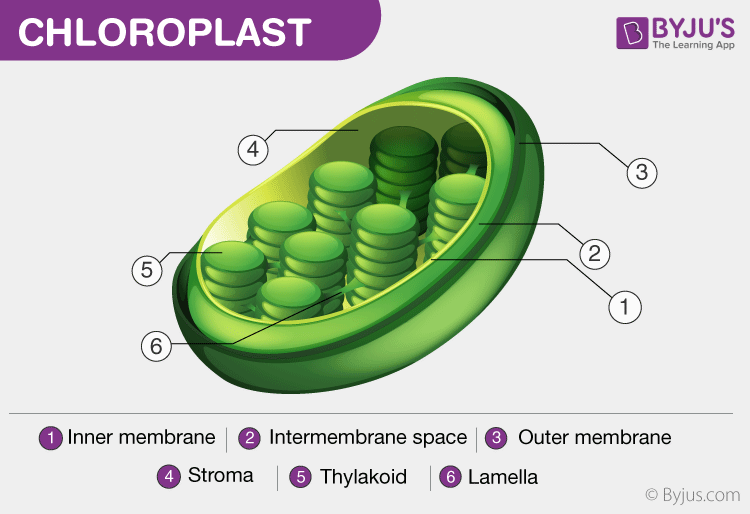Plants form the basis of all life on earth and are known as producers. Plant cells contain structures known as plastids which are absent in animal cells. These plastids are double-membraned cell organelles which play a primary role in the manufacturing and storing of food. There are three types of plastids –
- Chromoplasts- They are the colour plastids, found in all flowers, fruits and are mainly responsible for their distinctive colours.
- Chloroplasts- They are green coloured plastids, which comprise green-coloured pigments within the plant cell and are called chlorophyll.
- Leucoplasts- They are colourless plastids and are mainly used for the storage of starch, lipids and proteins within the plant cell.
Table of Contents
Let us have a detailed look at the chloroplast structure and function.
Chloroplast Definition
“Chloroplast is an organelle that contains the photosynthetic pigment chlorophyll that captures sunlight and converts it into useful energy, thereby, releasing oxygen from water. “
What is a Chloroplast?
Chloroplasts are found in all green plants and algae. They are the food producers of plants. These are found in mesophyll cells located in the leaves of the plants. They contain a high concentration of chlorophyll that traps sunlight. This cell organelle is not present in animal cells.
Chloroplast has its own extra-nuclear DNA and therefore are semiautonomous, like mitochondria. They also produce proteins and lipids required for the production of chloroplast membrane.
Also Read: Plastids
Diagram of Chloroplast
The chloroplast diagram below represents the chloroplast structure mentioning the different parts of the chloroplast. The parts of a chloroplast such as the inner membrane, outer membrane, intermembrane space, thylakoid membrane, stroma and lamella can be clearly marked out.

Chloroplast Diagram representing Chloroplast Structure
Structure of Chloroplast
Chloroplasts are found in all higher plants. It is oval or biconvex, found within the mesophyll of the plant cell. The size of the chloroplast usually varies between 4-6 µm in diameter and 1-3 µm in thickness. They are double-membrane organelle with the presence of outer, inner and intermembrane space. There are two distinct regions present inside a chloroplast known as the grana and stroma.
- Grana are made up of stacks of disc-shaped structures known as thylakoids or lamellae. The grana of the chloroplast consists of chlorophyll pigments and are the functional units of chloroplasts.
- Stroma is the homogenous matrix which contains grana and is similar to the cytoplasm in cells in which all the organelles are embedded. Stroma also contains various enzymes, DNA, ribosomes, and other substances. Stroma lamellae function by connecting the stacks of thylakoid sacs or grana.
The chloroplast structure consists of the following parts:
Membrane Envelope
It comprises inner and outer lipid bilayer membranes. The inner membrane separates the stroma from the intermembrane space.
Intermembrane Space
The space between inner and outer membranes.
Thylakoid System (Lamellae)
The system is suspended in the stroma. It is a collection of membranous sacs called thylakoids or lamellae. The green coloured pigments called chlorophyll are found in the thylakoid membranes. It is the sight for the process of light-dependent reactions of the photosynthesis process. The thylakoids are arranged in stacks known as grana and each granum contains around 10-20 thylakoids.
Stroma
It is a colourless, alkaline, aqueous, protein-rich fluid present within the inner membrane of the chloroplast present surrounding the grana.
Grana
Stack of lamellae in plastids is known as grana. These are the sites of conversion of light energy into chemical energy.
Chlorophyll
It is a green photosynthetic pigment that helps in the process of photosynthesis.
Also read: Light-dependent Reactions
Functions of Chloroplast
Following are the important chloroplast functions:
- The most important function of the chloroplast is to synthesise food by the process of photosynthesis.
- Absorbs light energy and converts it into chemical energy.
- Chloroplast has a structure called chlorophyll which functions by trapping the solar energy and is used for the synthesis of food in all green plants.
- Produces NADPH and molecular oxygen (O2) by photolysis of water.
- Produces ATP – Adenosine triphosphate by the process of photosynthesis.
- The carbon dioxide (CO2) obtained from the air is used to generate carbon and sugar during the Calvin Cycle or dark reaction of photosynthesis.
Also Refer: Calvin Cycle
Learn more about the chloroplast structure and function and other related topics only at BYJU’S Biology
Frequently Asked Questions
Where does the photosynthesis process occur in the plant cell?
In all green plants, photosynthesis takes place within the thylakoid membrane of the Chloroplast.
List out the different parts of Chloroplast?
Chloroplasts are cell organelles present only in a plant cell and it includes:
- Stroma
- Inner membrane
- Outer membrane
- Thylakoid membrane
- Intermembrane Space
What is the most important function of chloroplast?
The most important function of chloroplast is the production of food by the process of photosynthesis.
Why is the chloroplast green?
Chloroplast contains a green pigment called chlorophyll which gives it a green colour.
How many types of plastids are there?
There are three types of plastids-chloroplast, chromoplast and leucoplast.
What is the stack of lamellae inside a plastid called?
The stack of lamellae or thylakoids inside a plastid is called grana.

very good
Nice answers
Very nice
niiiiiiiiiiiiiiiice
very well explained.
Good work done
Very good answers
Good explanation
Niceeeee good work keep it up. ??
What is the definition of chloroplast
The chloroplast is an organelle that contains the photosynthetic pigment chlorophyll which uses sunlight to create energy which can be used by the plant.
Very good explanations I Loved it WELL DONE????
Really appreciate it
Nice job! This is really helpful! You guys explained it very well!
All this information is very helpful and I feel enriched and satisfied ? thanks for such explanations
I got a new idea, thanks, God bless you???
This is AMAZING work with precise key explanations to the point